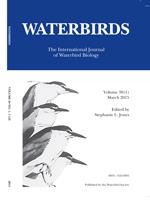Western (Aechmophorus occidentalis) and Clark's (A. clarkii) grebes are long-lived, migratory waterbirds that are sensitive to human-caused disturbance while nesting. Sampling the age distribution of post-hatch chicks provides a method for estimating the timing of nest initiation without causing disturbance to breeding colonies. The goals of this work were to describe trends in breeding productivity at two of the largest nesting colonies in northern California and illustrate how brood size can be used to evaluate nesting phenology in Aechmophorus grebes. No differences were found in brood size between species. Brood size decreased linearly as nest initiation date increased, showing no differences in the rate of decline among age classes of young. Within seasons, older broods were found to be significantly smaller than younger broods, suggesting that mortality was occurring after hatching thereby reducing the potential number of chicks recruited into the adult population.
How to translate text using browser tools
1 March 2015
Brood Size and Nesting Phenology in Western Grebe (Aechmophorus occidentalis) and Clark's Grebe (Aechmophorus clarkii) in Northern California
Kristofer M. Robison,
Daniel W. Anderson,
Renèe E. Robison
ACCESS THE FULL ARTICLE

Waterbirds
Vol. 38 • No. 1
March 2015
Vol. 38 • No. 1
March 2015
Aechmophorus clarkii
Aechmophorus occidentalis
brood size
Clark's Grebe
disturbance
nest initiation
nesting phenology




